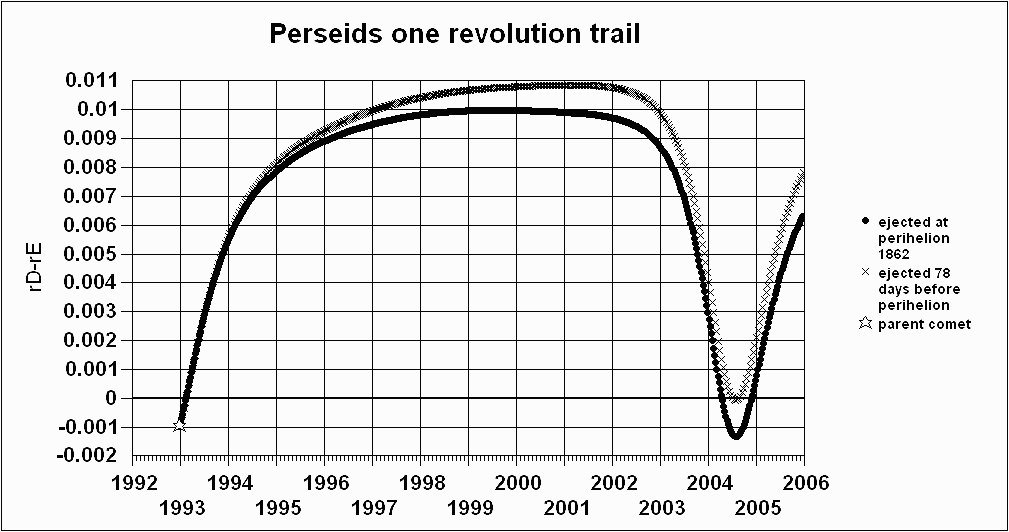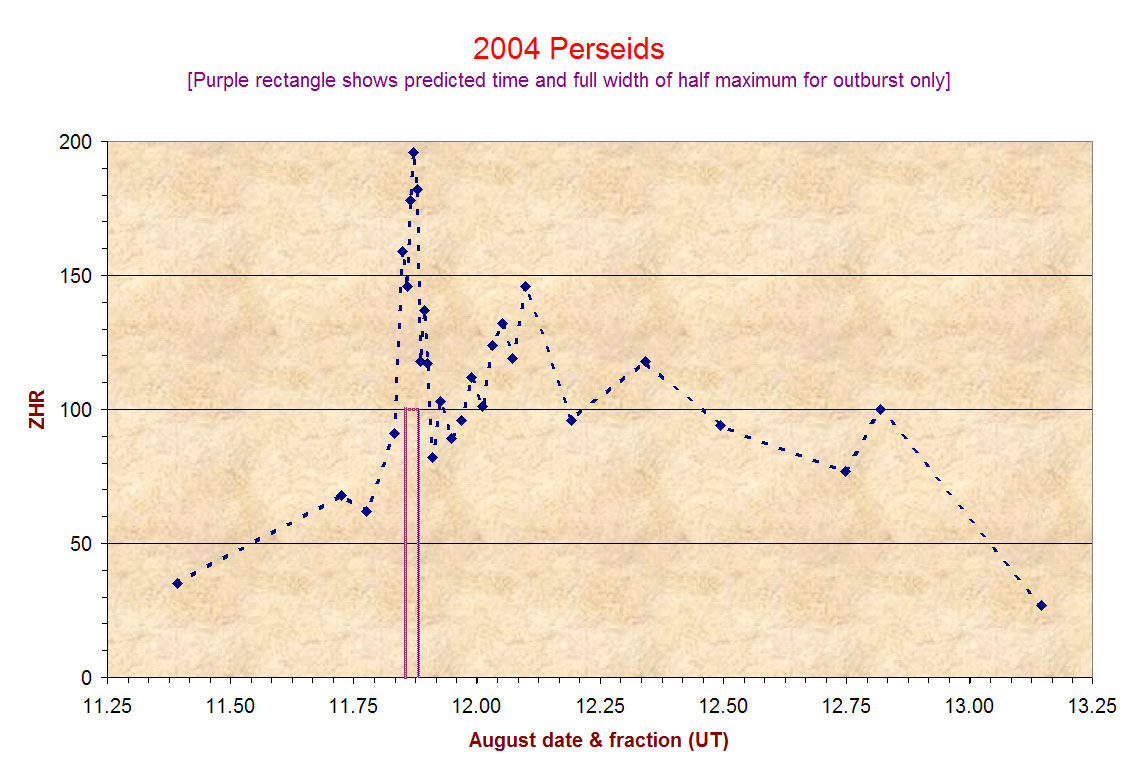Coming Perseid Meteor Storms
Esko Lyytinen -- 00/03/15
Abstract
The orbit of comet P/Swift-Tuttle has been passing outside the Earth’s orbit at least for the last 2000 years. The last return in 1992 was an exception. Already during the previous return in 1862, the perihelion distance might have had a lower value than during any of the previous history that can be reliably calculated. Four revolutions back, the perihelion distance was almost as low as in 1862. It is doubtful that the Earth has ever encountered a fresh meteor trail from this comet. In 2004, the one-revolution trail from 1862 will pass inside the Earth’s orbit. At the time of Perseids (the annual meteor shower associated with this comet), the rE-rD has a value of about +0.0012 au. Earth passes the trail node at solar longitude (2000.0) 139.441°. This occurs at 11 August 20:54 UT. If there were a closer approach, a real meteor storm would be expected. But with these conditions and no prior storms to judge by, it is uncertain what kind of a shower this will give. The Moon will be a relatively narrow waning crescent in 2004, with Europe and Western Asia in the most favorable viewing locations. The principles I use in my unpublished Leonid ZHR-model would give zenith hourly rates around 100 from this trail, if the numbers of particles released were the same as for Leonid-parent-comet Tempel-Tuttle. But since the Perseid parent comet is a lot bigger than the Leonid comet, there may be a chance of storm level activity. Because the planet Jupiter lowers the ecliptic crossing radii in general this year (2004), there may be enhanced general activity as well. The one-revolution trail may give a short shower with a half-strength duration of only about fifteen minutes. In the year 2028, the Earth will pass within about -0.0004 au (rE-rD) of the 4-revolution trail from the year 1479, with a mean anomaly factor of about 0.15. I expect this to produce a real storm over the U.S., although under unfavorable moonlight conditions.

Figure 1. The ecliptic crossing of 1-to-4-revolution meteor trails left by comet Swift-Tuttle. In the calculations, the original particle density is the same for 1-to-3-rev. trails. For the 4-rev. trail, the density is four times bigger. For the 1 rev. trail, the number of visible meteors is expected to start to decline more than about 10 years behind the comet. So prospects for a good shower from the 1-revolution trail are clearly best in 2004. In each figure, the vertical line is the start of the year. Similarly, the line at the location 2005 extending a bit downward from the others (for example) denotes the start of the year 2005. Visible Perseids meteors occur at about 0.61 of the way through each year.

Figure 2. The 1-revolution trail at a different scale in 2004. The year is divided into 12 months.

Figure 3. The 4-revolution trail plotted after the year 2020. The trail is getting irregular, but the number of visible meteors within the trail is expected to be dense enough in 2028 to give storm-level activity. This shower/storm is expected on 12 August at about 05:30 UT.
UPDATE
2004/05/26:
Here is the abstract and conclusion from the just-published WGN article on the 2004 outburst by Lyytinen & Van Flandern titled “Perseid one-revolution outburst in 2004”, WGN (J. of Int’l. Meteor Org.) 32:2, 51-53 (2004):
Abstract
In 2004, August 11 at about 21h UT, the one revolution dust trail of the Perseids parent comet Swift-Tuttle is calculated to pass within 0.0013 AU from the Earth's orbit and we expect this to cause a moderately strong, short outburst of mainly visually dim meteors. We have drawn conclusions from our (Lyytinen, TVF) prediction model that has been quite successful in predicting recent Leonids storms. We also discuss the possibility of enhanced yearly rates because perturbations by Jupiter will now direct all incoming Perseids meteoroids about 0.01 AU closer to the Sun, which allows the possibility of Earth passing through the densest core of the yearly stream.
Conclusions
With the Moon at waning crescent phase on August 11, observing conditions for the 2004 Perseids meteor activity should be excellent everywhere. Because the radiant is at a high northern declination (+58°), most northern hemisphere observers may expect to see meteors throughout the night. Observers will not want to be north of 60° latitude or so because of the "midnight Sun" in summer. Nor will they want to be below about latitude -32° because the radiant will never rise above their horizon.
Using techniques that have had considerable success in predicting the times, locations, and rates for meteor storms and shower peaks for both Leonids and Ursids, we expect that even the annual activity of the Perseids may be better than normal this year. Observations possibly confirming this or rejecting this will be valuable. This will help in mapping the stream and be used in predicting what to expect in the next similar situation in the year 2016. Even before this, in the year 2009 the planet Saturn makes a similar even slightly stronger ‘dip’ into the incoming meteoroids stream.
But as Figure 1 (below) shows, conditions for the following years will revert to more typical meteor rates. Perseids activity this strong or better is not predicted again until the year 2028.
In 2004, a possible meteor outburst of mostly fainter-than-average meteors may be seen on August 11 around 21h UT, with the optimum time occurring at 20h 50m UT. That will be daylight hours for the Western Hemisphere, but in darkness for most of the Eastern Hemisphere. Asia will be best situated for observing this outburst. The full width of half-maximum rate is predicted to last about 40 minutes.

Figure 1. The Perseids one revolution trail ecliptic crossing relative to the Earth orbit. Year symbols indicate the start of each year. The black dots mark the nominal trail-center location. The crosses indicate the meteoroids ejected (in 1862) at the distance of 1.7 AU before perihelion.
RESULTS
2004/08/14:
(data courtesy of Rainer Arit, International Meteor Organization)
The plot shows both the outburst at the predicted time with the predicted duration, and enhanced activity for the annual shower over the two days plotted as well. (ZHRs are 50-60 in a typical year.) This of course lends additional credence to the larger model underlying the predictions, the “exploded planet hypothesis”, which has these meteors escaping from orbits in a “debris cloud” around a comet nucleus instead of ejected into space via jets on the comet nucleus.

